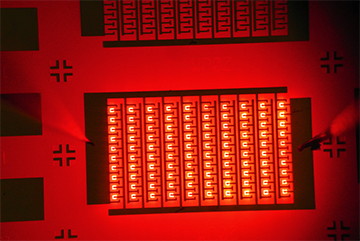
A team at Saudi Arabia’s King Abdullah University of Science and Technology (KAUST) has created 10×10 arrays of bright red microLEDs, each only 17×17 µm in area. [Image: Kazuhiro Ohkawa]
Downsizing is a big game in electronics. An advance in LED technology could now open the door to a generation of smaller, yet still high-resolution, displays.
Researchers in Saudi Arabia have created what they view as a promising technique for creating micro-LEDs—ones that measure just 17 µm2 in area. The powerful LEDs, the team believes, could eventually be used in mobile phones and head-mounted monitors (Photon. Res., doi: 10.1364/PRJ.428168).
Smoothing the sidewalls
In the past, attempts to shrink LEDs to micrometer scale have run into fabrication issues that affect the LEDs’ light emission. Defects in the tiny, fragile sidewalls of such LEDs allow current to leak out, lowering the light output, particularly for red microLEDs. This has limited functional LED size to no smaller than 400 µm2.
The team behind the new work attacked the problem head-on, by finding a way to address the sidewall leaks. The researchers started by carefully laying down indium gallium nitride (InGaN) red LED epitaxial wafers using a metal organic vapor-phase epitaxy (MOVPE) process the lab had pioneered several years back. Then, they used standard photolithography to etch out a 10×10 array of 17×17-µm microLED mesas.
In a final step, the team cleaned up the sidewalls of the red LEDs through a carefully monitored wet chemical etching process. The chemical etching removed the sidewall defects that typically lead to light loss. The researchers evaluated the LEDs with a range of atomic-scale assessments, like scanning and high-resolution transmission electron microscopy. The results showed the sidewalls were defect-free after fabrication, which helped contain and direct the LED’s light.
With the improved sidewalls, the new micro-LEDs significantly improved on the light power output density relative to other micro-LEDs¾jumping from 1 milliwatt per square millimeter to 1.76 milliwatts.
“The highly intense output of red micro-LEDs is the strong point in this paper,” said co-author and research lead Kazuhiro Ohkawa of King Abdullah University of Science and Technology, Saudi Arabia.
All the colors of the rainbow
The researchers also achieved a wide range of emitted colors by using monochromatic arrays, which demonstrated the LEDs’ potential for ultra-high-resolution displays. This was accomplished with arrays made of InGaN, which can emit the three colors¾red, green and blue¾needed to create a full rainbow.
In the future, the researchers plan to continue working on improving the LEDs’ efficiency, as well as on making them smaller.
